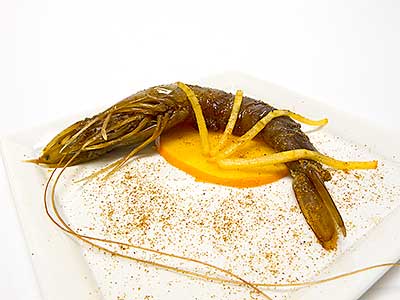December 2, 2013
Amuse-Bouche

crevette en saumure
(pickled shrimp)
I’d hold them up and say, “What’s the difference between these two bottles?” In response I’d get answers that varied from blank stares to genuine attempts to discern a difference other than what the titles on the bottles declared. This was an audience that generally thought of soy sauce as the little bottle with the red plastic top that was omnipresent on the tables of cheap Chinese restaurants. When I held up the two bottles, one labeled “Pearl River Brand Superior Light Soy Sauce” and the other labeled “Pearl River Brand Superior Dark Soy Sauce”, the group members were befuddled by my question.
I asked the same question on each of the culinary tours I led in San Francisco’s Chinatown neighborhood during the 1980s. The walks always occurred on Saturday mornings just before lunch when the neighborhood was most busy. Towards the end of the walk, the group would stop at the now-gone Metro Market on Broadway between Grant Avenue and Stockton Street to discuss Chinese packaged ingredients. The store was larger than most and sat at the edge of the busiest part of the quarter. Because of its size, I could enter the store with a group of tourists and not disturb the store’s normal commerce.
After the usual chorus of blank stares and the occasional attempt at a logical answer, I’d hand the bottles to one of the tour members and ask him or her to read out loud the ingredients of each of the bottles. Even then, only about half the group would notice that the difference was the inclusion of sugar in the dark soy sauce.
No one ever asked why there was a difference in sodium levels between the two varieties. Which was good. I didn’t know the answer back then. Now I know that salt is an added ingredient and the level can be controlled to some extent. Common soy sauces from China and Japan list on their labels sodium amounts close to 1 gram per tablespoon. This means that soy sauce, as is commonly known, is salty. But how salty?
Salt and sodium are not the same. Sodium is a component of salt. (I’m using the term salt in this case to mean table salt, the common term for sodium chloride.) By weight salt is about 40 percent sodium. That 1 gram per tablespoon of sodium becomes 2.5 grams of salt per tablespoon. Since 1 tablespoon of soy sauce has a mass of about 15 grams, the percentage of salt in soy sauce is about 1⁄6, or about 17 percent. This makes soy sauce over four times “saltier” than seawater.
Recently, when I asked the members of The Cult of Pre-Pasteurian Preservation and Food Preparation on Facebook whether I was brining as well as marinating when I used a soy-sauce-based marinade, I hadn’t thought about using soy sauce straight out of the bottle to ferment food. What I asked was “As I set some meat into a soy-sauce-based marinade for 30 hours, I did a little calculation and determined that the salinity of the marinade was 4%. Does that mean I’m brining as well as marinating?” By the time the responses evolved to the concept of fermentation, one responder challenged me with “Well, only one way to find out. Do it.” So I did.
Since I had previous experience with miso-fermenting, a similar process, of a couple of seafood items, scallops and oysters, I decided to start with seafood for the soy sauce experiment. The first attempt was performed with shrimp. I happened to be at the market, and there on sale were whole, decent-sized shrimp. So I bought a few.
When I returned home, I used a pair of heavy scissors to cut the shell around the abdomen (tail) up its back from the carapace (body) to the uropod (tail tip). I was careful to leave the shell intact and properly attached to the flesh below it. The particular scissors use also, by accident rather than design, make a shallow incision in the flesh below the shell. Through the cut shell and shallow incision I removed the intestine that runs the length of the abdomen. After a brief rinse in cold water, the shrimp were arranged in a plastic container. The container was filled with Japanese, amakuchi-style soy sauce—I had an unopened bottle in the cupboard that I bought by accident—and placed in the refrigerator.
I had originally planned to let the shrimp ferment for an arbitrarily determined ten days, but after four days my curiosity and impatience won out. I took one of the shrimp from the container and gave it a rinse. The flesh was a deep brown color with a slight green tinge. I peeled the shell off the abdomen, and cut it from the carapace and uropod. The flesh was brownish throughout, but regions farther from the surface were much lighter than those near the surface. After tasting, I decided that the shrimp was as salty as I would want it to become. The time was too short to fully ferment and preserve the shrimp, but that wasn’t my primary interest.
When it came time to serve the rest of the shrimp. I carefully peeled just the abdomens. I then sliced the abdomens crosswise in a couple of places. Each shrimp was then reassembled on a thin slice of persimmon, and thin strips of persimmon were used to cover the cut lines. The whole ensemble was sprinkled lightly with a yuzu-based shichimi powder I obtained on a recent trip to Kyoto. The persimmon and shichimi were just items I had on hand.
The soy-sauce marinating⁄brining⁄fermenting produced a nice-tasting morsel of shrimp. An idea worth repeating in the near future.
© 2013 Peter Hertzmann. All rights reserved.
